MURRAY ADVOGADOS

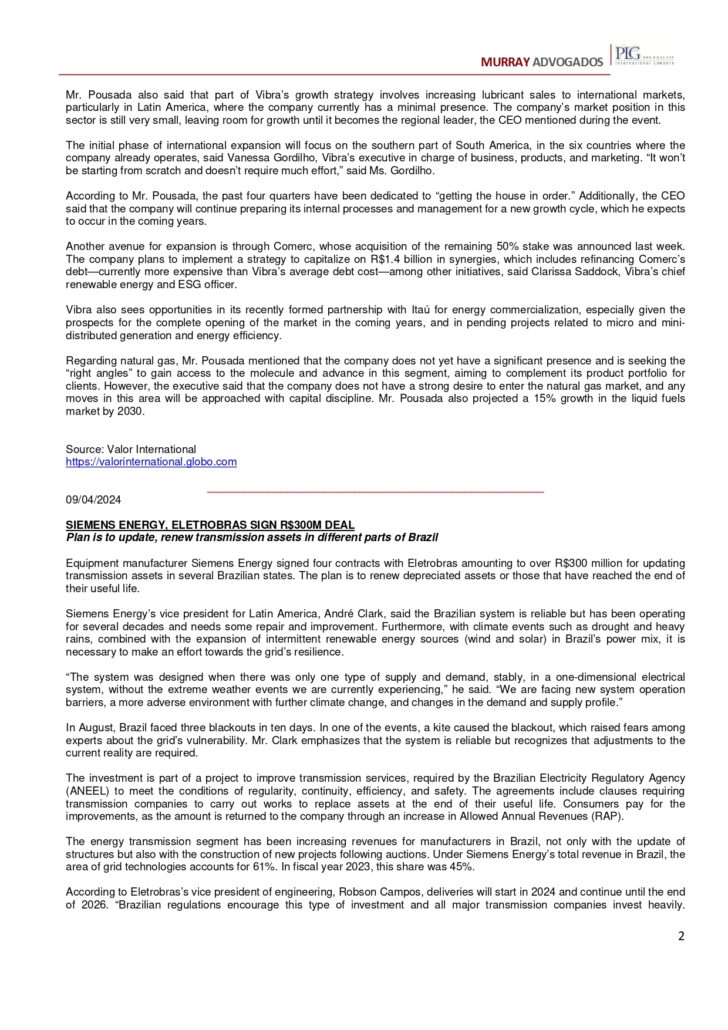
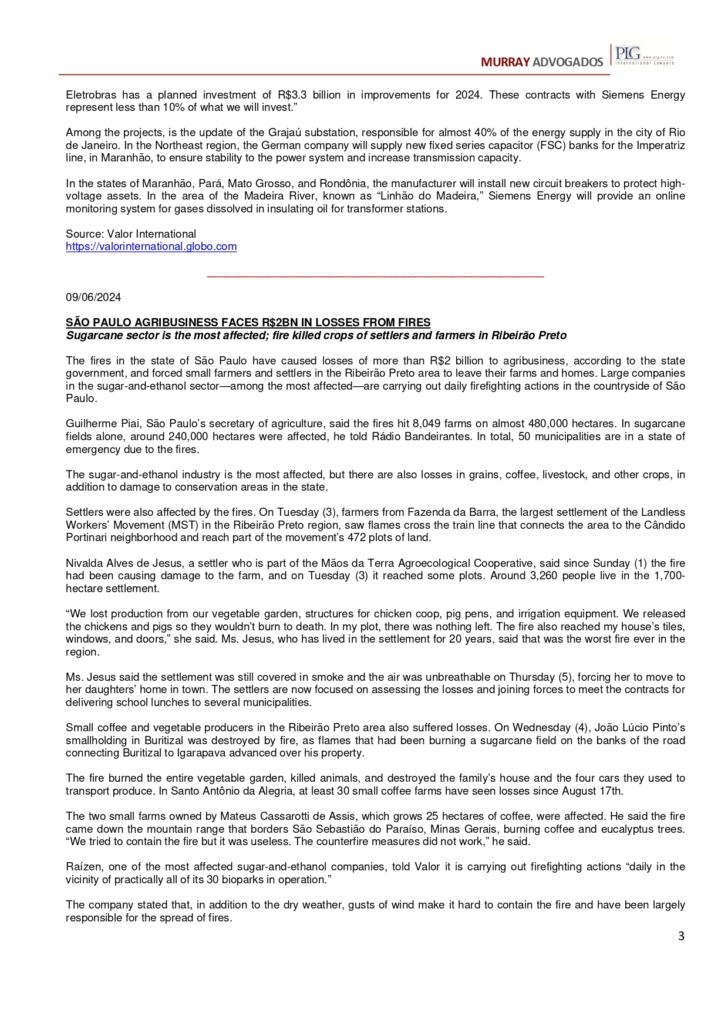
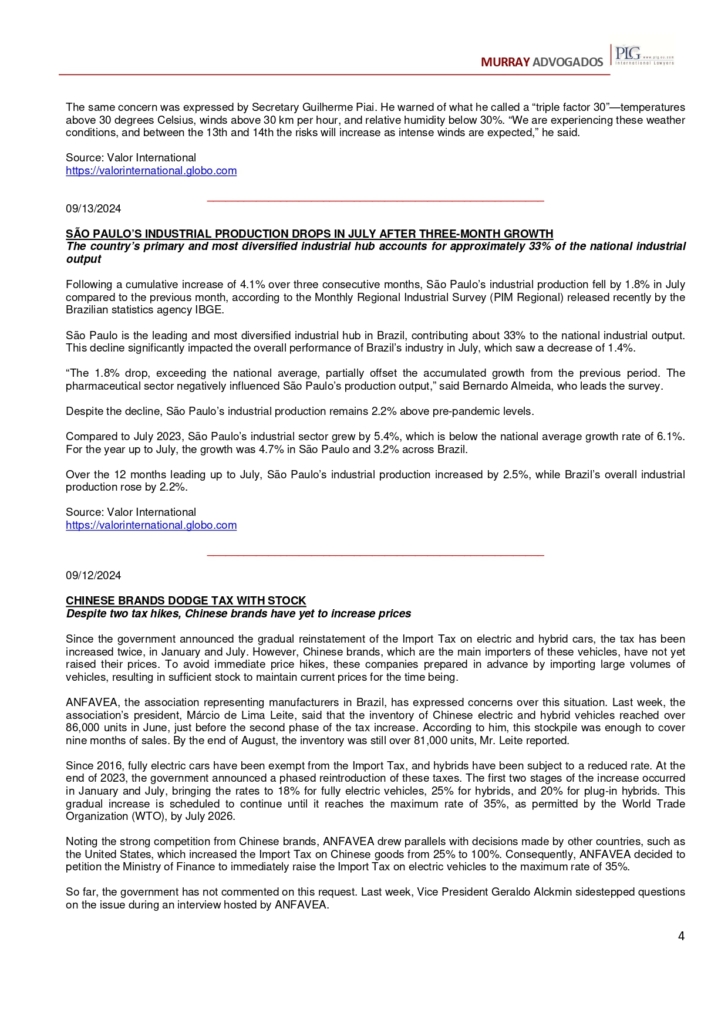
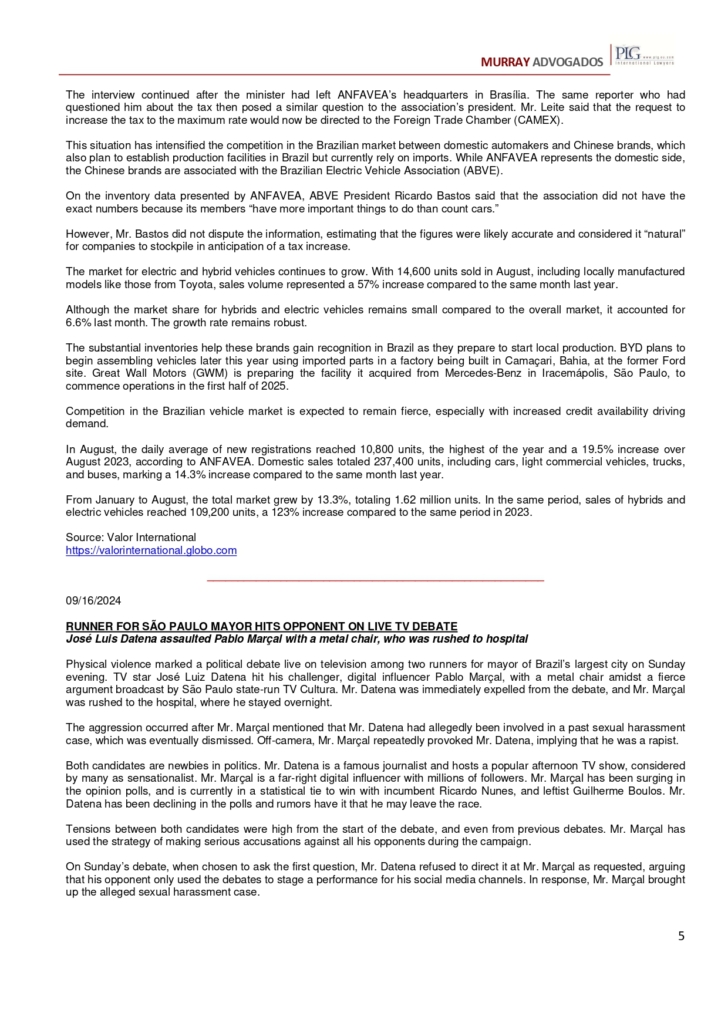
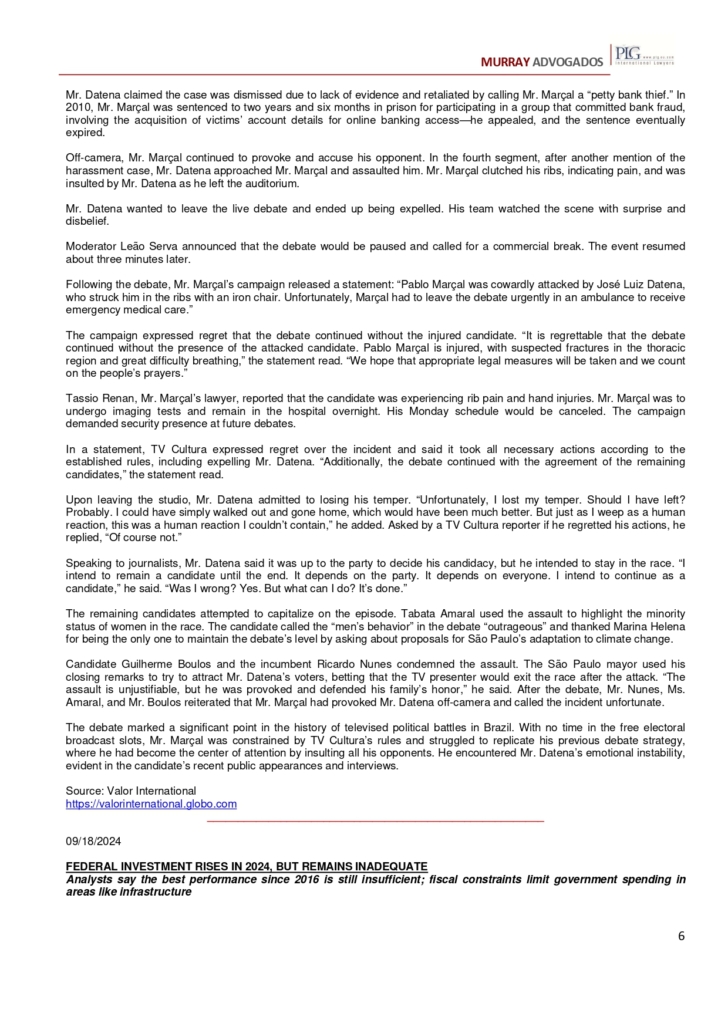

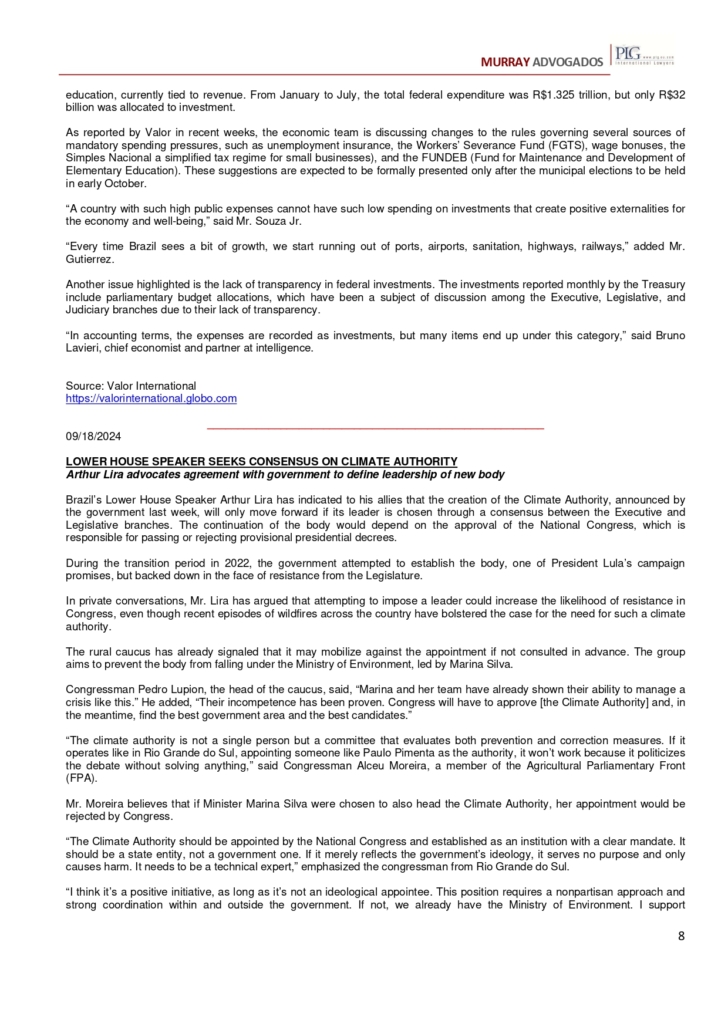
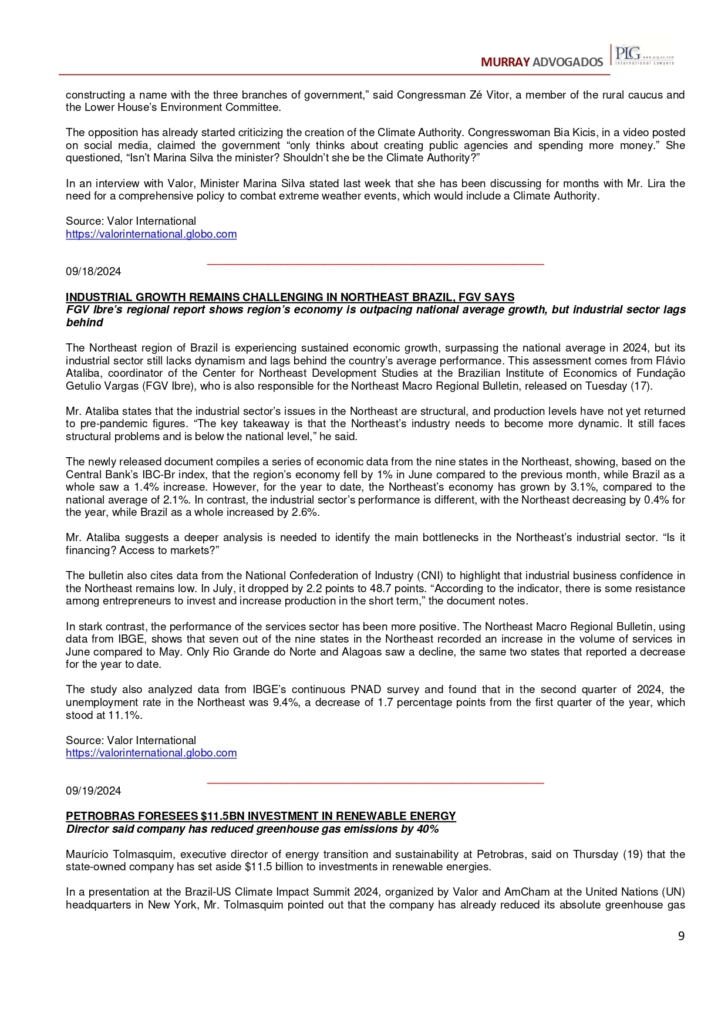
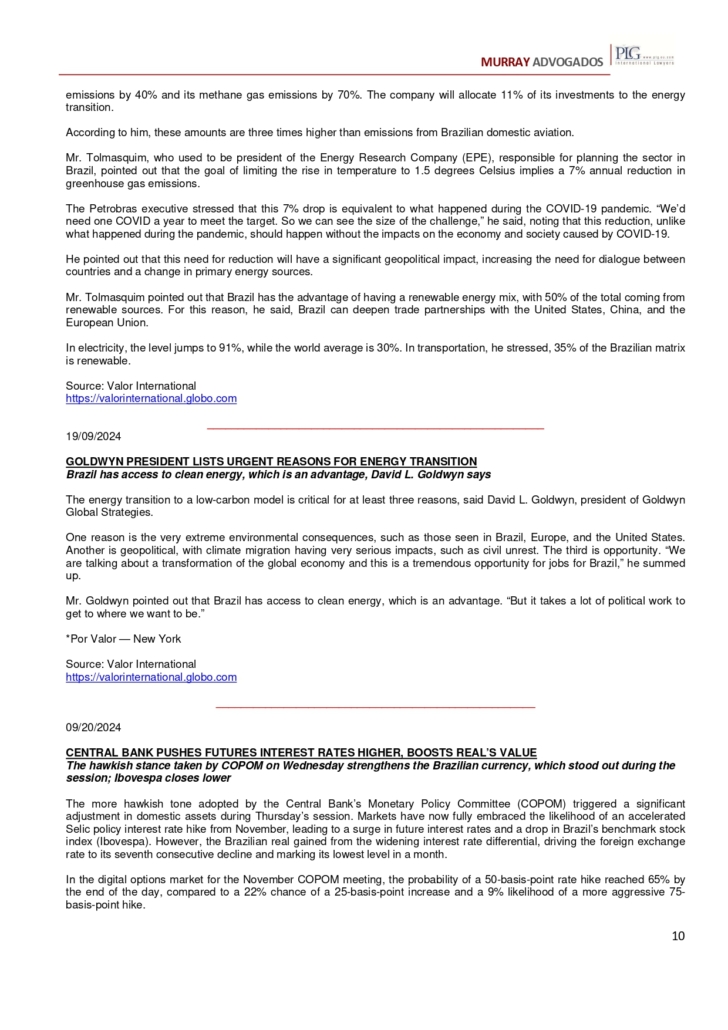
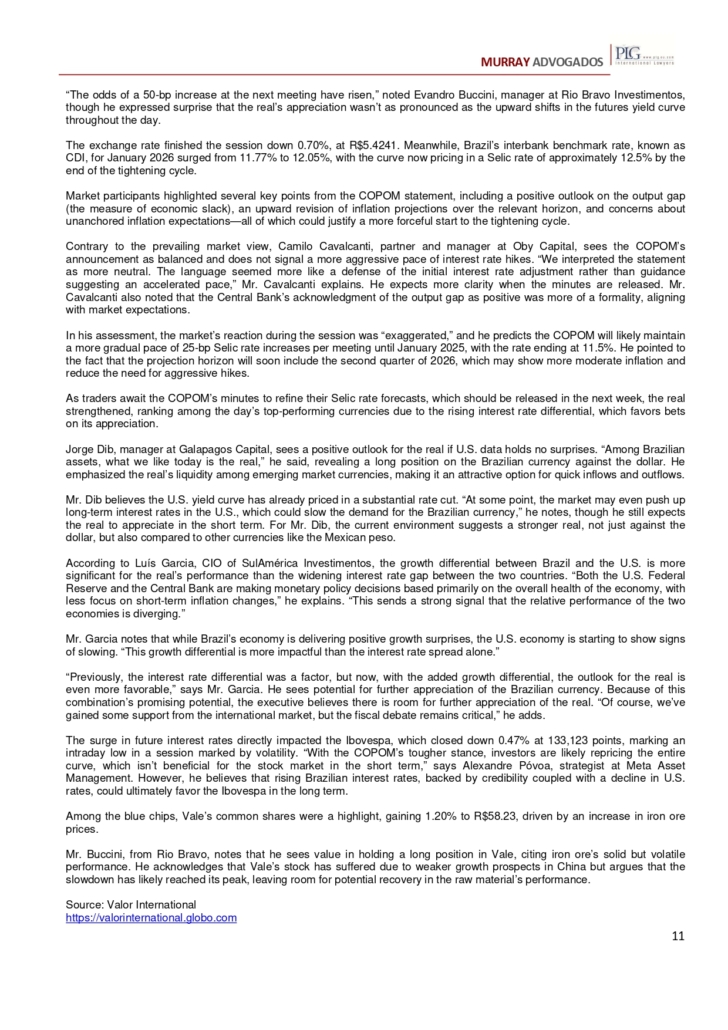


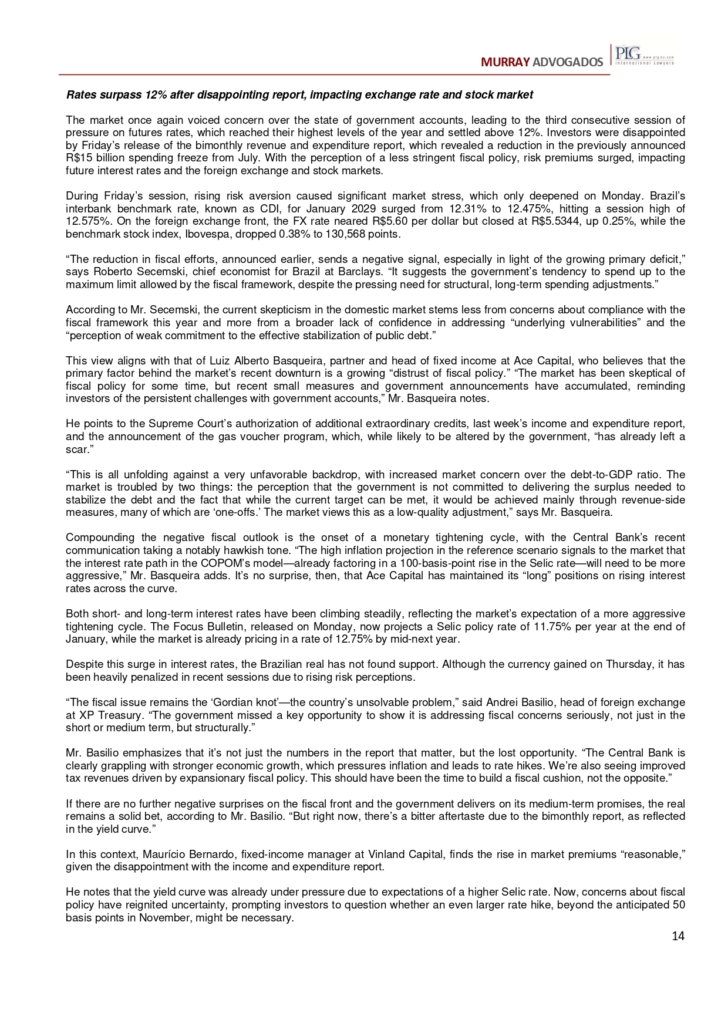
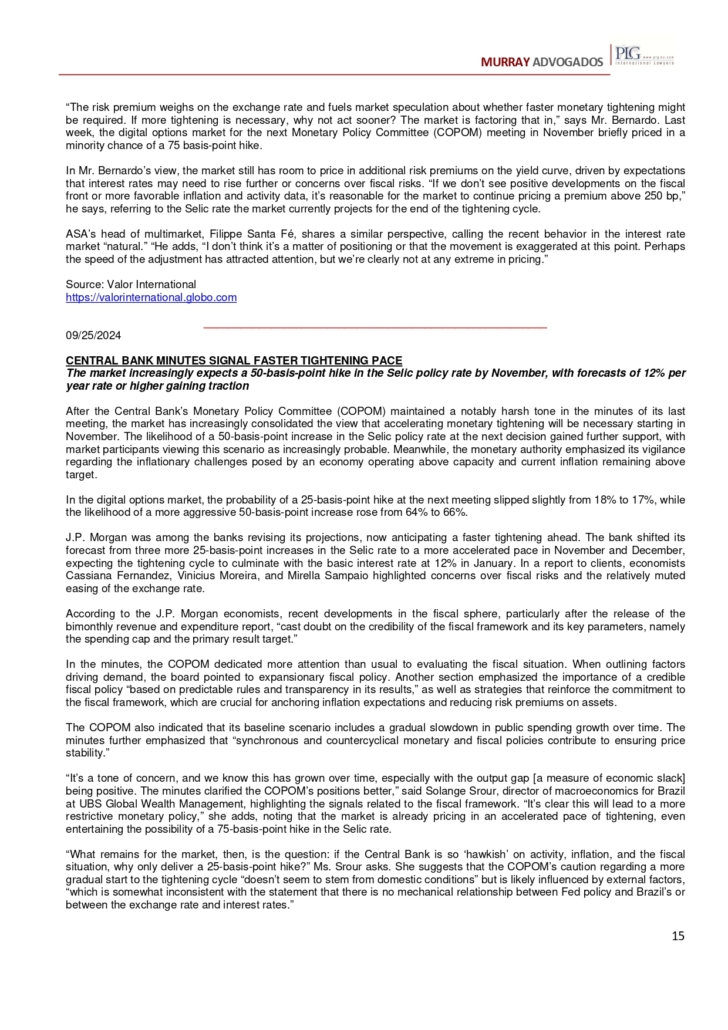
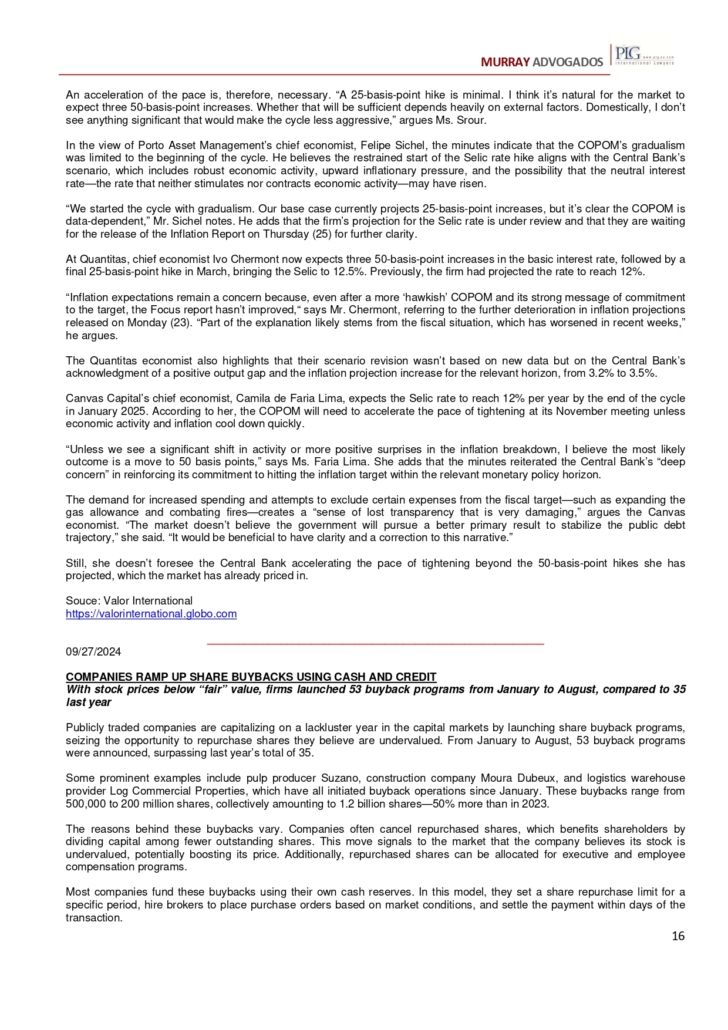
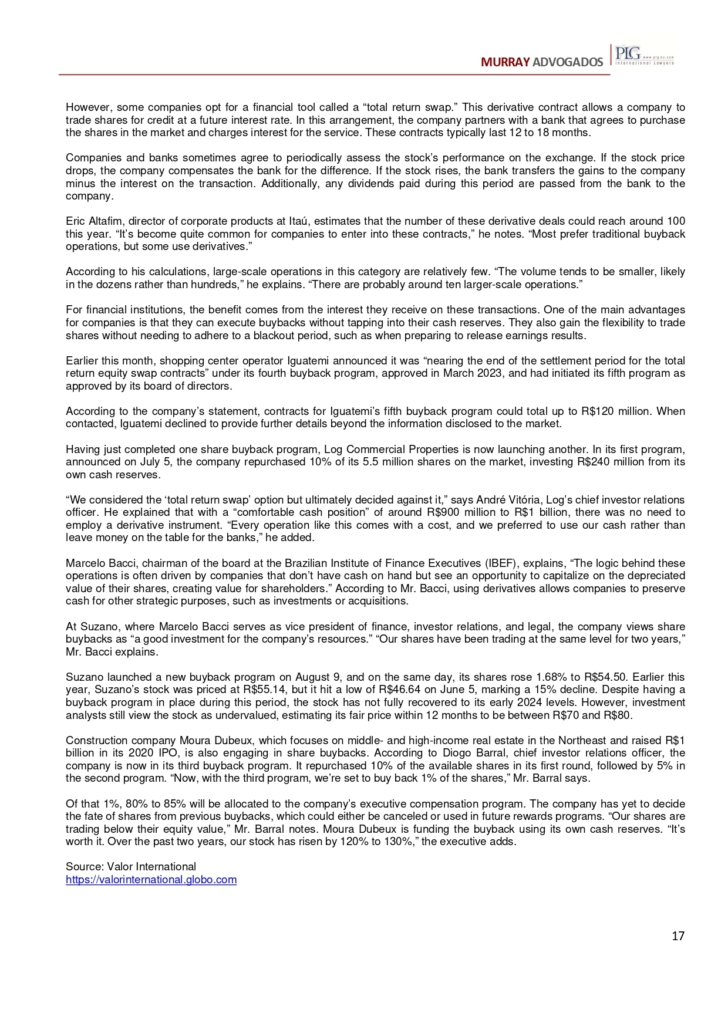
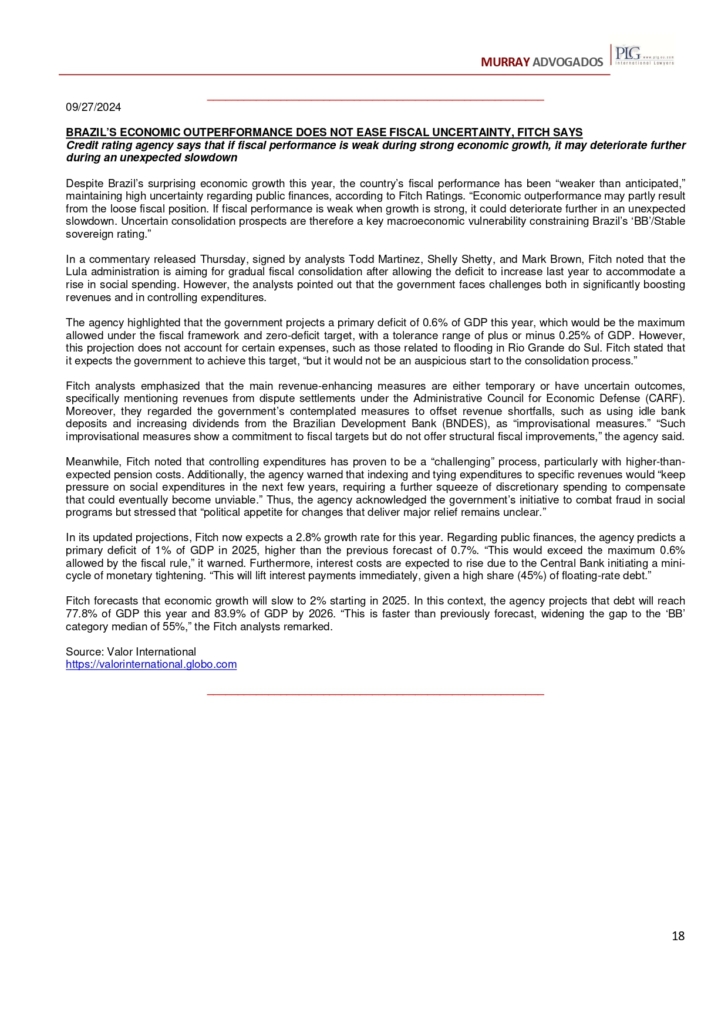
MURRAY ADVOGADOS


















10/01/2024 01:47 PM Atualizado 01/10/2024
Oleon, a Belgian subsidiary of the French group Avril and a global leader in natural-based oleochemicals, has finalized the purchase of Brazil’s A. Azevedo Oils, a prominent manufacturer of vegetable oils and its products—particularly those derived from castor beans. The companies did not disclose the transaction amount but noted that the family that previously owned A. Azevedo will retain a significant minority stake.
This acquisition marks Oleon’s entry into the Brazilian market, aligning with its strategy for global expansion and sustainable growth. A. Azevedo, which was advised by IGC Partners during the sale process, has an annual revenue of $80 million and employs 250 people. It will now be part of a company that generates €1 billion annually, with 1,200 employees and manufacturing facilities in seven countries, including Brazil.
The Brazilian company can produce 75,000 tonnes of vegetable oils per year, primarily from palm, soy, and especially castor beans. Its products serve as raw materials for cosmetics, packaging, fertilizers, cleaning products, and paints. Some of its production, carried out in its 30,000-square meter industrial facility in Itupeva, São Paulo, is already exported to the United States, France, and Latin American countries such as Argentina, Chile, Colombia, and Peru.
Oleon CEO Moussa Naciri said the acquisition gives Oleon access to the South American market, while the Brazilian company gains the opportunity to enter new markets.
“We can use A. Azevedo as a platform to develop Oleon in South America. And we can leverage Oleon to enable A. Azevedo to grow internationally,” Mr. Naciri said, adding that products related to the castor bean supply chain are “extremely important” in various applications.
Mr. Naciri cited examples such as automotive oils used in several vehicles in Europe, as well as pharmaceutical and cosmetic products. “We take these natural materials and transform them into high-value solutions,” he said, adding that while environmental discussions are relevant, Oleon’s products are competitive without subsidies. “We are in the market not just because we are green. We are there because we provide functionalities that are crucial for the product,” he said.
The Avril group, which controls Oleon, is the fifth largest agricultural group in France, operating in 19 countries, with annual revenues of €8 billion and 8,000 employees. Avril CEO Jean-Phillippe Puig noted that the company is managed through a fund created by farmers who still control the company, aiming to increase the group’s annual earnings by €200 million by 2030.
*By Rafael Rosas — Rio de Janeiro
Source: Valor International
10/01/2024
/i.s3.glbimg.com/v1/AUTH_63b422c2caee4269b8b34177e8876b93/internal_photos/bs/2024/j/a/PWVGBOSTSae4HTAPqrbQ/foto01fin-101-balanco-c6.jpg)
September felt like all of 2024 unfolded in a single month. It featured the expected rate cut by the U.S. Federal Reserve, a hike in Brazil’s Selic policy rate, and even stimulus measures for China’s economy. The renewed monetary tightening in Brazil kept fixed income in focus, making it the top performer for the month, with a CDI (Interbank Deposit Certificate) return of 0.84%. For the quarter, the rate stood at 2.63%. Meanwhile, after a strong August where Brazil’s benchmark stock index Ibovespa rose by 6.54%, it ended September down 3.08%, with a quarterly decline of 6.38%. The U.S. dollar declined by 3.30% against the real in September and 2.53% over the quarter.
“The best asset of the month was the CDI, outperforming the Ibovespa, real estate investment funds, and a basket of inflation-linked securities,” said Marcelo Mello, CEO of asset manager SulAmérica Vida, Previdência e Investimentos. He mentioned that fixed income attracted over R$43 billion in September, mainly into credit funds, while multimarket funds saw outflows of R$40 billion and equities lost R$2 billion. On the other hand, the pension funds segment gained R$4.5 billion.
Mr. Mello noted that both the rate cut in the U.S. and Brazil’s monetary tightening had been anticipated, with the key question being the pace. The Federal Reserve, he explained, started with a stronger approach, with its base rate potentially reaching 3.5% this year, while Brazil’s tightening began more cautiously, with a 25 basis-point hike but a tougher stance, leading the market to project 50 bp increases at each meeting. SulAmérica Vida expects the Selic rate to reach 12.5% per year by the end of the cycle.
“We began the year expecting more rate cuts in Brazil, which would have opened a window for IPOs, but the opposite happened,” Mr. Mello summarized. However, while the tighter monetary policy directly impacts Brazilian assets, it doesn’t rule out a stock market recovery. The monetary easing in the U.S. opens the door for a rebound, with the expected return of foreign investor inflows, along with the boost from China’s stimulus package. “China’s stimulus measures provide a lift to commodities, although it’s still uncertain if they’ll be enough,” Mr. Mello pointed out.
For Tiago Cunha, equity manager at Ace Capital, the domestic environment offers little incentive for riskier investments, and the government’s fiscal policy signals don’t inspire confidence. However, the external outlook—with moderate U.S. economic growth, falling interest rates, and China’s stimulus package—is starting to influence foreign investors’ portfolios.
“Everyone was expecting the Chinese stimulus package, but there was no clear indication of when it would happen, which is why all positions related to the country were at historic lows. Now we’re seeing a boost in these positions, especially through emerging markets funds, and Brazil ends up benefiting from this,” Mr. Cunha said.
Mr. Mello, of SulAmérica, noted that while equities aren’t very attractive to domestic institutional investors, he also sees international flows coming into emerging markets as U.S. rates fall. “For the stock market, what’s most relevant isn’t China, but U.S. rates,” he said. “Stocks are trading at a discount, and companies have been reporting satisfactory results. If the U.S. monetary policy direction is confirmed, we could see foreign inflows.”
Mr. Cunha, from Ace, also mentioned that foreign investors are puzzled by Brazil’s divergent path on interest rates compared to the rest of the world. “They struggle to understand, especially given that the inflation we’re trying to control isn’t far off target. It raises questions about how often the market consistently overestimates inflation and underestimates economic activity.”
For him, since the extent of the tightening cycle is unclear, it’s also impossible to predict when rate cuts will resume. “If it depends on anchoring expectations, there’s the additional challenge of aligning fiscal policy with this.” Amid all volatility in expectations, the IMA-B 5+ (an index reflecting the performance of government bonds indexed to the IPCA official inflation with maturities over five years) fell 1.42% in September, while the IMA-B 5 (up to five years) rose 0.4%. Over the quarter, the indexes saw gains of 2.55% and 1.92%, respectively.
In equities, indexes linked to domestic activity, given the forecast of a stronger Selic rate hike, fell more than the Ibovespa: the Small Caps index dropped 4.41%, and the Icon retail index declined 4.71%. “The economic data has been strong, and we want to be more optimistic, but we’re being cautious,” said Marcelo Nantes, head of equities at ASA.
Mr. Nantes recalled that August was a good month for stocks tied to the domestic economy, but the firm thought equities had risen too much and started September more cautiously. “New money for the stock market is coming from foreign investors because it’s very difficult for pension funds to invest with interest rates at this level. And retail investors are focusing on tax-exempt securities.”
He said that with the results of China’s stimulus package still unknown, the asset manager is “more in wait-and-see mode than willing to take a gamble,” which is why they kept a small exposure to commodities and reduced their position in companies tied to Brazil’s GDP. The healthcare sector, as well as shopping malls and retail in general, are part of this group. “We like these sectors and made only small adjustments. We also doubled the fund’s cash allocation.”
There were no changes in the electricity sector exposure, where they remained optimistic, and the telecommunications industry allocation grew. “China’s move has turned into a positive risk, and Brazilian activity remains strong, but the fiscal issue is the elephant in the room. If foreign flows return, we’ll revise our view.” At Ace, they maintain a bullish position on commodities while increasing their exposure to technology companies overseas.
The bet on Brazilian stocks isn’t significant at G5 Partners, said Fernando Donnay, partner and head of fund-of-funds at the multifamily office, with an allocation between 5% and 10%, considered neutral. The largest portion of its equity portfolio is invested overseas, where stocks may not be as cheap as in Brazil, but it focuses on global companies. On the other hand, in fixed income, the firm is reducing its allocation, as the risk premiums on private securities continue to shrink.
Mr. Mello, from SulAmérica, also pointed to the ongoing reduction in spreads as a challenge for credit allocations. He noted that some asset managers are starting to limit inflows into their funds to maintain portfolio quality, especially those with daily liquidity.
He believes that as these fundraising limits expand, the market will stabilize. SulAmérica itself has already closed its daily liquidity funds, and on platforms, they’re working to encourage funds with 60 and 90-day maturities, which allow for the pursuit of more competitive rates.
Gabriel Esteca, co-founder and head of infrastructure at Bocaina Capital, doesn’t foresee a change in the high demand for infrastructure bonds, which offer tax exemptions for individual investors. He has been targeting smaller issuances, up to R$100 million, which the firm originates to secure higher rates. “There’s no visible trigger in the short term due to the high demand for credit.”
*By Liane Thedim — Rio de Janeiro
Source: Valor International
10/01/2024
/i.s3.glbimg.com/v1/AUTH_37554604729d4b2f9f3eb9ad8a691345/internal_photos/bs/2022/E/U/FIkesCTXCEbGgCQR8paw/310322-20ibiuna-20024.jpg)
The ongoing Selic benchmark interest rate hike, which began in September, is expected to impact the financial performance of companies raising funds through the debt market, particularly those in highly leveraged sectors such as retail, car rentals, and healthcare. However, the fallout is likely to be less severe than in 2021, when the rapid increase in Brazil’s policy interest rate to 13.75% from 2% over just a year strained these companies’ ability to manage their debt costs. This time, many firms acted preemptively, capitalizing on strong demand for bonds to refinance at lower spreads and extended maturities.
“Some companies that access capital markets have issued new debt, allowing them to swap higher-cost obligations for lower spreads and longer terms, reducing short-term rollover risks,” explains Vivian Lee, partner and manager at Ibiuna. “But for those already facing liquidity pressures, the rate increase is anything but trivial.”
A report from the SWM Group obtained by Valor highlights that certain cyclical sectors, such as car rentals, food and textile retailers, and healthcare providers are in a more precarious leverage position. “With the rise in the Selic rate, these companies are seeing either an increase or, at best, stabilization of leverage due to higher financial costs,” says Odilon Costa, SWM’s fixed income and corporate debt strategist. “Investors need to be cautious, as the credit fundamentals of some issuers have become more concerning. The risk-return balance of these assets deserves closer attention.”
Mr. Costa notes that rental companies are facing heightened leverage due to a combination of fleet maintenance and expansion needs, coupled with a decline in used vehicle prices. Meanwhile, food and textile retailers have benefited from more robust consumer spending but are still grappling with tight credit conditions and stiffer competition. For healthcare companies, including hospitals and laboratories, costs have eased somewhat, though payment delays from operators remain a significant challenge, according to the SWM report.
With profit margins as low as 5% to 10% and high levels of debt, any increase in the Selic rate could significantly erode companies’ net results, says Rosana Pádua, board member of the Brazilian Institute of Finance Executives of São Paulo (IBEF-SP). “In some cases, companies don’t even have enough margin to service their debt. That’s why many have struggled since rates increased and have filed for court-supervised reorganization.”
From the funding perspective, the latest Selic adjustment to 10.75% per year from 10.5% hasn’t impacted companies’ decisions to issue bonds. According to Miguel Diaz, Santander’s capital markets specialist, firms generally focus more on the spread they’ll pay investors rather than the total financial cost.
“The spread is the main criterion for deciding whether to move forward. It’s different from the bond market, where the emphasis is on the overall cost of financing,” he explains. Mr. Diaz adds that the rate hike could even lead to an increase in available resources for funds.
Vivian Lee from Ibiuna Capital agrees that if interest rates continue to rise as expected, the flow of funds to corporate debt investments is unlikely to be affected. However, if the Selic climbs above 14% per year, individual investors may shift their capital toward more liquid options like CDBs from large banks or government bonds. “At that point, the impact on companies’ financial expenses will be much greater, and credit risk will rise,” she cautions, noting that Ibiuna’s baseline scenario does not currently foresee a Selic rate reaching 14%.
The previous rate hike cycle, which began in 2021, hit Brazilian companies hard. Many had taken advantage of the 2% Selic rate to increase their debt, aiming to finance post-pandemic expansion. However, deteriorating macroeconomic conditions, rising commodity prices, and the devaluation of the real led the Central Bank to sharply raise the Selic rate, peaking at 13.75% in August 2022, the highest since 2016.
This time around, if interest rates climb too much, the benefits of issuing debt at lower rates earlier this year could be wiped out, says Mr. Costa. “The effort to reduce spreads may be negated by a rise in the CDI (interbank short-term rate),” he notes. “At the beginning of the year, the premium on the most liquid debentures dropped from CDI plus 2.3% to CDI plus 1.6%, a 70-basis-point reduction. But if the Selic rises by 150 basis points, the nominal cost of debt will climb much higher.”
Last week’s Focus Bulletin projected the Selic rate to be 11.5% by the end of the year. However, after the Central Bank’s Inflation Report, some market players began betting on a more aggressive rate hike to keep inflation within target, with some institutions forecasting a 12.5% rate at the peak of the tightening cycle. In the latest Focus report, the median expectation edged up to 11.75%.
*By Rita Azevedo — São Paulo
Source: Valor Internatinal
09/27/2024
/i.s3.glbimg.com/v1/AUTH_63b422c2caee4269b8b34177e8876b93/internal_photos/bs/2020/6/o/WzeSSBRGu8YqU2xjIz7w/060220fitch-20ratings032.jpg)
Despite Brazil’s surprising economic growth this year, the country’s fiscal performance has been “weaker than anticipated,” maintaining high uncertainty regarding public finances, according to Fitch Ratings. “Economic outperformance may partly result from the loose fiscal position. If fiscal performance is weak when growth is strong, it could deteriorate further in an unexpected slowdown. Uncertain consolidation prospects are therefore a key macroeconomic vulnerability constraining Brazil’s ‘BB’/Stable sovereign rating.”
In a commentary released Thursday, signed by analysts Todd Martinez, Shelly Shetty, and Mark Brown, Fitch noted that the Lula administration is aiming for gradual fiscal consolidation after allowing the deficit to increase last year to accommodate a rise in social spending. However, the analysts pointed out that the government faces challenges both in significantly boosting revenues and in controlling expenditures.
The agency highlighted that the government projects a primary deficit of 0.6% of GDP this year, which would be the maximum allowed under the fiscal framework and zero-deficit target, with a tolerance range of plus or minus 0.25% of GDP. However, this projection does not account for certain expenses, such as those related to flooding in Rio Grande do Sul. Fitch stated that it expects the government to achieve this target, “but it would not be an auspicious start to the consolidation process.”
Fitch analysts emphasized that the main revenue-enhancing measures are either temporary or have uncertain outcomes, specifically mentioning revenues from dispute settlements under the Administrative Council for Economic Defense (CARF). Moreover, they regarded the government’s contemplated measures to offset revenue shortfalls, such as using idle bank deposits and increasing dividends from the Brazilian Development Bank (BNDES), as “improvisational measures.” “Such improvisational measures show a commitment to fiscal targets but do not offer structural fiscal improvements,” the agency said.
Meanwhile, Fitch noted that controlling expenditures has proven to be a “challenging” process, particularly with higher-than-expected pension costs. Additionally, the agency warned that indexing and tying expenditures to specific revenues would “keep pressure on social expenditures in the next few years, requiring a further squeeze of discretionary spending to compensate that could eventually become unviable.” Thus, the agency acknowledged the government’s initiative to combat fraud in social programs but stressed that “political appetite for changes that deliver major relief remains unclear.”
In its updated projections, Fitch now expects a 2.8% growth rate for this year. Regarding public finances, the agency predicts a primary deficit of 1% of GDP in 2025, higher than the previous forecast of 0.7%. “This would exceed the maximum 0.6% allowed by the fiscal rule,” it warned. Furthermore, interest costs are expected to rise due to the Central Bank initiating a mini-cycle of monetary tightening. “This will lift interest payments immediately, given a high share (45%) of floating-rate debt.”
Fitch forecasts that economic growth will slow to 2% starting in 2025. In this context, the agency projects that debt will reach 77.8% of GDP this year and 83.9% of GDP by 2026. “This is faster than previously forecast, widening the gap to the ‘BB’ category median of 55%,” the Fitch analysts remarked.
*By Victor Rezende, Valor — São Paulo
Source: Valor International
09/27/2024
/i.s3.glbimg.com/v1/AUTH_37554604729d4b2f9f3eb9ad8a691345/internal_photos/bs/2024/9/5/LE3p88QAauPgvyXBqfBQ/100724suzano30.jpg)
Publicly traded companies are capitalizing on a lackluster year in the capital markets by launching share buyback programs, seizing the opportunity to repurchase shares they believe are undervalued. From January to August, 53 buyback programs were announced, surpassing last year’s total of 35.
Some prominent examples include pulp producer Suzano, construction company Moura Dubeux, and logistics warehouse provider Log Commercial Properties, which have all initiated buyback operations since January. These buybacks range from 500,000 to 200 million shares, collectively amounting to 1.2 billion shares—50% more than in 2023.
The reasons behind these buybacks vary. Companies often cancel repurchased shares, which benefits shareholders by dividing capital among fewer outstanding shares. This move signals to the market that the company believes its stock is undervalued, potentially boosting its price. Additionally, repurchased shares can be allocated for executive and employee compensation programs.
Most companies fund these buybacks using their own cash reserves. In this model, they set a share repurchase limit for a specific period, hire brokers to place purchase orders based on market conditions, and settle the payment within days of the transaction.
However, some companies opt for a financial tool called a “total return swap.” This derivative contract allows a company to trade shares for credit at a future interest rate. In this arrangement, the company partners with a bank that agrees to purchase the shares in the market and charges interest for the service. These contracts typically last 12 to 18 months.
Companies and banks sometimes agree to periodically assess the stock’s performance on the exchange. If the stock price drops, the company compensates the bank for the difference. If the stock rises, the bank transfers the gains to the company minus the interest on the transaction. Additionally, any dividends paid during this period are passed from the bank to the company.
Eric Altafim, director of corporate products at Itaú, estimates that the number of these derivative deals could reach around 100 this year. “It’s become quite common for companies to enter into these contracts,” he notes. “Most prefer traditional buyback operations, but some use derivatives.”
According to his calculations, large-scale operations in this category are relatively few. “The volume tends to be smaller, likely in the dozens rather than hundreds,” he explains. “There are probably around ten larger-scale operations.”
For financial institutions, the benefit comes from the interest they receive on these transactions. One of the main advantages for companies is that they can execute buybacks without tapping into their cash reserves. They also gain the flexibility to trade shares without needing to adhere to a blackout period, such as when preparing to release earnings results.
Earlier this month, shopping center operator Iguatemi announced it was “nearing the end of the settlement period for the total return equity swap contracts” under its fourth buyback program, approved in March 2023, and had initiated its fifth program as approved by its board of directors.
According to the company’s statement, contracts for Iguatemi’s fifth buyback program could total up to R$120 million. When contacted, Iguatemi declined to provide further details beyond the information disclosed to the market.
Having just completed one share buyback program, Log Commercial Properties is now launching another. In its first program, announced on July 5, the company repurchased 10% of its 5.5 million shares on the market, investing R$240 million from its own cash reserves.
“We considered the ‘total return swap’ option but ultimately decided against it,” says André Vitória, Log’s chief investor relations officer. He explained that with a “comfortable cash position” of around R$900 million to R$1 billion, there was no need to employ a derivative instrument. “Every operation like this comes with a cost, and we preferred to use our cash rather than leave money on the table for the banks,” he added.
Marcelo Bacci, chairman of the board at the Brazilian Institute of Finance Executives (IBEF), explains, “The logic behind these operations is often driven by companies that don’t have cash on hand but see an opportunity to capitalize on the depreciated value of their shares, creating value for shareholders.” According to Mr. Bacci, using derivatives allows companies to preserve cash for other strategic purposes, such as investments or acquisitions.
At Suzano, where Marcelo Bacci serves as vice president of finance, investor relations, and legal, the company views share buybacks as “a good investment for the company’s resources.” “Our shares have been trading at the same level for two years,” Mr. Bacci explains.
Suzano launched a new buyback program on August 9, and on the same day, its shares rose 1.68% to R$54.50. Earlier this year, Suzano’s stock was priced at R$55.14, but it hit a low of R$46.64 on June 5, marking a 15% decline. Despite having a buyback program in place during this period, the stock has not fully recovered to its early 2024 levels. However, investment analysts still view the stock as undervalued, estimating its fair price within 12 months to be between R$70 and R$80.
Construction company Moura Dubeux, which focuses on middle- and high-income real estate in the Northeast and raised R$1 billion in its 2020 IPO, is also engaging in share buybacks. According to Diogo Barral, chief investor relations officer, the company is now in its third buyback program. It repurchased 10% of the available shares in its first round, followed by 5% in the second program. “Now, with the third program, we’re set to buy back 1% of the shares,” Mr. Barral says.
Of that 1%, 80% to 85% will be allocated to the company’s executive compensation program. The company has yet to decide the fate of shares from previous buybacks, which could either be canceled or used in future rewards programs. “Our shares are trading below their equity value,” Mr. Barral notes. Moura Dubeux is funding the buyback using its own cash reserves. “It’s worth it. Over the past two years, our stock has risen by 120% to 130%,” the executive adds.
*By Nelson Rocco, Rita Azevedo — São Paulo
Source: Valor International
09/27/2024
/i.s3.glbimg.com/v1/AUTH_37554604729d4b2f9f3eb9ad8a691345/internal_photos/bs/2024/y/O/yFNADCSUyPzlGa52RNuA/475ae156-ac90-47a5-b025-5b08dfd414be.jpg)
The Central Bank’s inflation projections, which remain above the target throughout the forecast horizon, as highlighted in the Inflation Report released on Thursday, have strengthened expectations of further tightening the Selic rate in the coming months. Financial institutions are now adjusting their forecasts to reflect a higher policy rate.
However, Central Bank President Roberto Campos Neto avoided signaling future moves, emphasizing a “data-dependent” approach. “We need more data and more time to understand how [the cycle] will proceed,” he said.
Since the Central Bank’s Monetary Policy Committee (COPOM) began its rate-hike cycle last week and the minutes released on Tuesday (24) echoed the same hawkish tone, the Inflation Report has been perceived as another firm signal from the monetary authority.
The report shows that inflation projections fail to return to the target in any timeframe. The Central Bank estimates the 2024 IPCA at 4.3%, with inflation at 3.7% in 2025. In the first two quarters of 2026—key periods in the relevant monetary policy horizon—inflation is forecast at 3.5%. Even in the first quarter of 2027, the most distant projection, inflation stands at 3.2%, still above the 3% target pursued by the COPOM.
“The Central Bank anticipates the need for restrictive monetary conditions until at least the end of 2026, and the market’s reference trajectory for the Selic policy rate and the real do not align with inflation projections meeting the 3% target over the next two and a half years,” said Alberto Ramos, head of macroeconomic research for Latin America at Goldman Sachs.
The COPOM revised its output gap projections, a measure of economic slack. The indicator is now estimated at 0.5% for the second and third quarters of 2024, up from 0% to 0.2% in the previous report. For the fourth quarter of 2024, the output gap is projected at 0.3%, down from 0.4%. Looking ahead to the first quarter of 2026, the estimate remains at 0.3%.
The data presented in the report has led many financial institutions to conclude that the Selic rate may need to be higher than the 11.5% projected in the Focus Report to bring inflation back to target. Throughout the day, some institutions, including BTG Pactual, began expecting a Selic rate of 12.5% by the end of the tightening cycle.
BTG now foresees three consecutive hikes of 50 basis points in November, December, and January, followed by a final 25-basis-point increase in March.
In a note from BTG’s chief economist for Brazil, Claudio Ferraz, the bank pointed out that the Inflation Report data sends a “hawkish” message, reinforcing COPOM’s communication since last week’s meeting.
BTG highlighted the “substantial revision” in 2024 economic growth projections and noted that the output gap has moved into positive territory. Despite this, the inflation projection for the second quarter of 2026, just after the COPOM’s relevant monetary policy horizon, still shows a high Extended Consumer Price Index (IPCA) of 3.5%.
“The September communication shows that the COPOM acknowledged stronger-than-expected economic activity and sees a more challenging process in converging inflation to the target, citing upward asymmetry in its balance of risks,” the economists added.
The Buysidebrazil consultancy, founded and led by economist Andrea Damico, mapped a similar trajectory for the Selic rate after the release of the Inflation Report. The firm highlighted that the revision of the output gap adds 35 basis points to inflation by the end of the first quarter of 2026, which falls within the relevant horizon for monetary policy. According to their calculations, this increase is partially offset by the higher interest rate outlook, which reduces the inflation projection by 25 basis points.
Marcelo Fonseca, chief economist at Reag Investimentos, noted that the Inflation Report did not introduce any new information beyond what was outlined in the statement and minutes of the last COPOM meeting. Still, it implicitly suggests that the Central Bank will accelerate the Selic rate hike to 50 basis points starting in November, Mr. Fonseca said.
“The Central Bank is clearly committed to ensuring inflation convergence, and to achieve that, it will need to deliver a longer tightening cycle than most analysts and the market initially anticipated,” explained Mr. Fonseca, whose projection is also for the Selic rate to reach 12.5%, with the cycle concluding in March. Reag revised its forecast shortly after the previous COPOM meeting.
While the COPOM started the current tightening cycle with a more modest 25-basis-point increase, Mr. Fonseca believes this decision was specific to the context of the September meeting.
During a recent interview, Mr. Campos Neto clarified that no discussion took place regarding a more aggressive 50-basis-point hike in week three of September. “Had a group considered a 50-basis-point increase, we would have noted it in the minutes. Since it’s not there, that debate didn’t happen,” Mr. Campos Neto explained.
When asked about the recent IPCA figures, Mr. Campos Neto acknowledged some qualitatively better signs, reiterating his previous comment that short-term inflation could be “a little better.” However, he also expressed concerns over future price dynamics, particularly food prices related to ongoing drought conditions. Brazil’s mid-September inflation index IPCA-15—known as a reliable predictor for official inflation—showed a 0.13% increase in September, significantly below market expectations.
The release of the Inflation Report notably impacted the interest rate market, especially for intermediate-term contracts. By the end of the session, the January 2026 DI rate rose from 12.085% to 12.20%, while the January 2027 DI increased from 12.11% to 12.245%.
Based on the yield curve, projections now indicate that the Selic rate could reach 12.75% by 2025.
Regarding market reactions, Mr. Campos Neto stated it is not the Central Bank’s role to “keep commenting on whether we agree or disagree with the market,” after being questioned about his earlier remarks concerning a potential overreaction in risk premiums.
By Gabriel Roca, Gabriel Caldeira, Anaïs Fernandes, Gabriel Shinohara, Alex Ribeiro, Victor Rezende, Estevão Taiar — São Paulo and Brasília*
Source: Valor International
09/25/2024
/i.s3.glbimg.com/v1/AUTH_37554604729d4b2f9f3eb9ad8a691345/internal_photos/bs/2023/x/Q/bsHGZzT7SotfsMRDun0Q/041223ubsglobal9.jpg)
After the Central Bank’s Monetary Policy Committee (COPOM) maintained a notably harsh tone in the minutes of its last meeting, the market has increasingly consolidated the view that accelerating monetary tightening will be necessary starting in November. The likelihood of a 50-basis-point increase in the Selic policy rate at the next decision gained further support, with market participants viewing this scenario as increasingly probable. Meanwhile, the monetary authority emphasized its vigilance regarding the inflationary challenges posed by an economy operating above capacity and current inflation remaining above target.
In the digital options market, the probability of a 25-basis-point hike at the next meeting slipped slightly from 18% to 17%, while the likelihood of a more aggressive 50-basis-point increase rose from 64% to 66%.
J.P. Morgan was among the banks revising its projections, now anticipating a faster tightening ahead. The bank shifted its forecast from three more 25-basis-point increases in the Selic rate to a more accelerated pace in November and December, expecting the tightening cycle to culminate with the basic interest rate at 12% in January. In a report to clients, economists Cassiana Fernandez, Vinicius Moreira, and Mirella Sampaio highlighted concerns over fiscal risks and the relatively muted easing of the exchange rate.
According to the J.P. Morgan economists, recent developments in the fiscal sphere, particularly after the release of the bimonthly revenue and expenditure report, “cast doubt on the credibility of the fiscal framework and its key parameters, namely the spending cap and the primary result target.”
In the minutes, the COPOM dedicated more attention than usual to evaluating the fiscal situation. When outlining factors driving demand, the board pointed to expansionary fiscal policy. Another section emphasized the importance of a credible fiscal policy “based on predictable rules and transparency in its results,” as well as strategies that reinforce the commitment to the fiscal framework, which are crucial for anchoring inflation expectations and reducing risk premiums on assets.
The COPOM also indicated that its baseline scenario includes a gradual slowdown in public spending growth over time. The minutes further emphasized that “synchronous and countercyclical monetary and fiscal policies contribute to ensuring price stability.”
“It’s a tone of concern, and we know this has grown over time, especially with the output gap [a measure of economic slack] being positive. The minutes clarified the COPOM’s positions better,” said Solange Srour, director of macroeconomics for Brazil at UBS Global Wealth Management, highlighting the signals related to the fiscal framework. “It’s clear this will lead to a more restrictive monetary policy,” she adds, noting that the market is already pricing in an accelerated pace of tightening, even entertaining the possibility of a 75-basis-point hike in the Selic rate.
“What remains for the market, then, is the question: if the Central Bank is so ‘hawkish’ on activity, inflation, and the fiscal situation, why only deliver a 25-basis-point hike?” Ms. Srour asks. She suggests that the COPOM’s caution regarding a more gradual start to the tightening cycle “doesn’t seem to stem from domestic conditions” but is likely influenced by external factors, “which is somewhat inconsistent with the statement that there is no mechanical relationship between Fed policy and Brazil’s or between the exchange rate and interest rates.”
An acceleration of the pace is, therefore, necessary. “A 25-basis-point hike is minimal. I think it’s natural for the market to expect three 50-basis-point increases. Whether that will be sufficient depends heavily on external factors. Domestically, I don’t see anything significant that would make the cycle less aggressive,” argues Ms. Srour.
In the view of Porto Asset Management’s chief economist, Felipe Sichel, the minutes indicate that the COPOM’s gradualism was limited to the beginning of the cycle. He believes the restrained start of the Selic rate hike aligns with the Central Bank’s scenario, which includes robust economic activity, upward inflationary pressure, and the possibility that the neutral interest rate—the rate that neither stimulates nor contracts economic activity—may have risen.
“We started the cycle with gradualism. Our base case currently projects 25-basis-point increases, but it’s clear the COPOM is data-dependent,” Mr. Sichel notes. He adds that the firm’s projection for the Selic rate is under review and that they are waiting for the release of the Inflation Report on Thursday (25) for further clarity.
At Quantitas, chief economist Ivo Chermont now expects three 50-basis-point increases in the basic interest rate, followed by a final 25-basis-point hike in March, bringing the Selic to 12.5%. Previously, the firm had projected the rate to reach 12%.
“Inflation expectations remain a concern because, even after a more ‘hawkish’ COPOM and its strong message of commitment to the target, the Focus report hasn’t improved,“ says Mr. Chermont, referring to the further deterioration in inflation projections released on Monday (23). “Part of the explanation likely stems from the fiscal situation, which has worsened in recent weeks,” he argues.
The Quantitas economist also highlights that their scenario revision wasn’t based on new data but on the Central Bank’s acknowledgment of a positive output gap and the inflation projection increase for the relevant horizon, from 3.2% to 3.5%.
Canvas Capital’s chief economist, Camila de Faria Lima, expects the Selic rate to reach 12% per year by the end of the cycle in January 2025. According to her, the COPOM will need to accelerate the pace of tightening at its November meeting unless economic activity and inflation cool down quickly.
“Unless we see a significant shift in activity or more positive surprises in the inflation breakdown, I believe the most likely outcome is a move to 50 basis points,” says Ms. Faria Lima. She adds that the minutes reiterated the Central Bank’s “deep concern” in reinforcing its commitment to hitting the inflation target within the relevant monetary policy horizon.
The demand for increased spending and attempts to exclude certain expenses from the fiscal target—such as expanding the gas allowance and combating fires—creates a “sense of lost transparency that is very damaging,” argues the Canvas economist. “The market doesn’t believe the government will pursue a better primary result to stabilize the public debt trajectory,” she said. “It would be beneficial to have clarity and a correction to this narrative.”
Still, she doesn’t foresee the Central Bank accelerating the pace of tightening beyond the 50-basis-point hikes she has projected, which the market has already priced in.
*Por Gabriel Caldeira, Victor Rezende, Gabriel Shinohara, Alex Ribeiro — São Paulo and Brasília
Souce: Valor International
09/24/2024
/i.s3.glbimg.com/v1/AUTH_37554604729d4b2f9f3eb9ad8a691345/internal_photos/bs/2024/B/S/VAxbRcSYGhJiDpmjaXbg/eldorado-anna-carolina-negri-valor.png)
The president of the arbitration tribunal overseeing the dispute between J&F Investimentos and Paper Excellence over control of the pulp producer Eldorado, along with another arbitrator, resigned on Monday (23). According to letters reviewed by Valor, Juan Fernández-Armesto, who chaired the arbitration, and Paulo Mota Pinto stated that their decision was prompted by “direct threats” from the Batista family’s holding company, which owns meat producer JBS. The news was initially reported by columnist Malu Gaspar in the newspaper “O Globo.”
J&F did not respond to requests for comment.
“Given the direct threat against me, I no longer feel capable of making the decisions I believe to be just and in accordance with the law. Therefore, I am resigning,” Mr. Armesto stated in a document dated September 23.
These resignations are not the first in the Eldorado case and come amid new developments in a battle that has been ongoing for over six years. The latest issue revolves around a case in the Federal Regional Court of the 4th Region (TRF-4), which suspended the transfer of Eldorado shares to Paper more than a year ago.
While J&F claims that one of TRF-4’s decisions had already suspended the arbitration itself, Paper and the arbitration tribunal argue that only the transfer of controlling shares was suspended, along with the activities of the coordinating body established to balance decisions made at Eldorado. This is because Paper, which owns 49.41% of the pulp producer, has a minority stake on the board.
As a result, people familiar with the dispute said J&F had been asserting that the arbitration was violating a court ruling, risking legal penalties.
This clash of narratives was reflected in Itaú’s decision to withdraw from the dispute. The bank was the custodian of Paper’s funds for purchasing the shares of Eldorado still held by J&F, as well as the share book deposited in court by arbitration order. Itaú had sought clarification on the need to return the share book but ultimately ended the contract.
The partners were then given 60 days to find a new custodian, but no financial institution accepted the role. This deadline expired on September 16, and Itaú returned the share book to the company. According to people interviewed by Valor, J&F had sent notifications to these banks, indicating that acting as a depositary would constitute a breach of court ruling and a violation of the rights of both the holding and Eldorado.
Last week, the vice president of TRF-4, Judge João Batista Pinto Oliveira, ordered the suspension of the arbitration itself after a challenge from J&F. The president of the arbitration tribunal acknowledged this recent decision.
Judge Armesto said that the arbitration had always complied with judicial decisions, including those from TRF-4. For this reason, on September 20, he declared the arbitration suspended, following the second-instance judge’s position.
“While it is true that since the issuance of the partial ruling, J&F has adopted a confrontational approach with the Tribunal, this is the first time it has made such a brutal and ‘ad hominem’ threat, implying that I, as president, would be guilty of possible crimes of ‘malfeasance,’ ‘disobedience,’ or ‘abuse of authority,’” M. Armesto wrote.
Judge Mota Pinto, who joined the arbitration after Anderson Schreiber’s resignation—following accusations from J&F of omitting information that could indicate a conflict of interest—stated in his letter that the holding’s threats were directed not only at the presidency but at the entire tribunal.
“There are limits to the viability of establishing arbitration, which in this case have been largely exceeded concerning the president of the Arbitration Tribunal, regardless of the respect always due, asserted and practiced regarding the (better or worse) decisions of state courts,” he wrote.
“In any case, the threats directed at the Tribunal, along with the profound respect and full solidarity owed to the president…prevent me from continuing to serve as an arbitrator in this proceeding,” he added.
In a statement, Paper Excellence described the latest chapter in the dispute as “regrettable” and accused its partner of once again resorting to “criminal threats against some of the most renowned arbitrators worldwide, forcing their resignation.”
“This only confirms that J&F disregards contracts and the decisions against it, acting without the necessary seriousness and ethics in its business relationships,” it added, reiterating accusations that its partner uses “deceptive and dilatory procedural tactics to delay its inevitable defeat.”
J&F and Paper have been engaged in legal disputes across various courts since mid-2018, just before the Batista holding company annulled the purchase and sale contract for Eldorado, which was signed in September 2017. While Paper has won arbitration against its partner, it has yet to gain control of the pulp producer.
J&F is attempting to annul the arbitration ruling in a case currently proceeding in São Paulo’s judiciary. Furthermore, a TRF-4 decision has blocked the transfer of controlling shares based on legislation limiting land purchases by foreigners in the country for over a year.
*Por Stella Fontes — São Paulo
Source: Valor International
09/24/2024
/i.s3.glbimg.com/v1/AUTH_37554604729d4b2f9f3eb9ad8a691345/internal_photos/bs/2024/y/t/vjAU29TaKM6tEEPyawnA/210824vinlandcapital004.jpg)
The market once again voiced concern over the state of government accounts, leading to the third consecutive session of pressure on futures rates, which reached their highest levels of the year and settled above 12%. Investors were disappointed by Friday’s release of the bimonthly revenue and expenditure report, which revealed a reduction in the previously announced R$15 billion spending freeze from July. With the perception of a less stringent fiscal policy, risk premiums surged, impacting future interest rates and the foreign exchange and stock markets.
During Friday’s session, rising risk aversion caused significant market stress, which only deepened on Monday. Brazil’s interbank benchmark rate, known as CDI, for January 2029 surged from 12.31% to 12.475%, hitting a session high of 12.575%. On the foreign exchange front, the FX rate neared R$5.60 per dollar but closed at R$5.5344, up 0.25%, while the benchmark stock index, Ibovespa, dropped 0.38% to 130,568 points.
“The reduction in fiscal efforts, announced earlier, sends a negative signal, especially in light of the growing primary deficit,” says Roberto Secemski, chief economist for Brazil at Barclays. “It suggests the government’s tendency to spend up to the maximum limit allowed by the fiscal framework, despite the pressing need for structural, long-term spending adjustments.”
According to Mr. Secemski, the current skepticism in the domestic market stems less from concerns about compliance with the fiscal framework this year and more from a broader lack of confidence in addressing “underlying vulnerabilities” and the “perception of weak commitment to the effective stabilization of public debt.”
This view aligns with that of Luiz Alberto Basqueira, partner and head of fixed income at Ace Capital, who believes that the primary factor behind the market’s recent downturn is a growing “distrust of fiscal policy.” “The market has been skeptical of fiscal policy for some time, but recent small measures and government announcements have accumulated, reminding investors of the persistent challenges with government accounts,” Mr. Basqueira notes.
He points to the Supreme Court’s authorization of additional extraordinary credits, last week’s income and expenditure report, and the announcement of the gas voucher program, which, while likely to be altered by the government, “has already left a scar.”
“This is all unfolding against a very unfavorable backdrop, with increased market concern over the debt-to-GDP ratio. The market is troubled by two things: the perception that the government is not committed to delivering the surplus needed to stabilize the debt and the fact that while the current target can be met, it would be achieved mainly through revenue-side measures, many of which are ‘one-offs.’ The market views this as a low-quality adjustment,” says Mr. Basqueira.
Compounding the negative fiscal outlook is the onset of a monetary tightening cycle, with the Central Bank’s recent communication taking a notably hawkish tone. “The high inflation projection in the reference scenario signals to the market that the interest rate path in the COPOM’s model—already factoring in a 100-basis-point rise in the Selic rate—will need to be more aggressive,” Mr. Basqueira adds. It’s no surprise, then, that Ace Capital has maintained its “long” positions on rising interest rates across the curve.
Both short- and long-term interest rates have been climbing steadily, reflecting the market’s expectation of a more aggressive tightening cycle. The Focus Bulletin, released on Monday, now projects a Selic policy rate of 11.75% per year at the end of January, while the market is already pricing in a rate of 12.75% by mid-next year.
Despite this surge in interest rates, the Brazilian real has not found support. Although the currency gained on Thursday, it has been heavily penalized in recent sessions due to rising risk perceptions.
“The fiscal issue remains the ‘Gordian knot’—the country’s unsolvable problem,” said Andrei Basilio, head of foreign exchange at XP Treasury. “The government missed a key opportunity to show it is addressing fiscal concerns seriously, not just in the short or medium term, but structurally.”
Mr. Basilio emphasizes that it’s not just the numbers in the report that matter, but the lost opportunity. “The Central Bank is clearly grappling with stronger economic growth, which pressures inflation and leads to rate hikes. We’re also seeing improved tax revenues driven by expansionary fiscal policy. This should have been the time to build a fiscal cushion, not the opposite.”
If there are no further negative surprises on the fiscal front and the government delivers on its medium-term promises, the real remains a solid bet, according to Mr. Basilio. “But right now, there’s a bitter aftertaste due to the bimonthly report, as reflected in the yield curve.”
In this context, Maurício Bernardo, fixed-income manager at Vinland Capital, finds the rise in market premiums “reasonable,” given the disappointment with the income and expenditure report.
He notes that the yield curve was already under pressure due to expectations of a higher Selic rate. Now, concerns about fiscal policy have reignited uncertainty, prompting investors to question whether an even larger rate hike, beyond the anticipated 50 basis points in November, might be necessary.
“The risk premium weighs on the exchange rate and fuels market speculation about whether faster monetary tightening might be required. If more tightening is necessary, why not act sooner? The market is factoring that in,” says Mr. Bernardo. Last week, the digital options market for the next Monetary Policy Committee (COPOM) meeting in November briefly priced in a minority chance of a 75 basis-point hike.
In Mr. Bernardo’s view, the market still has room to price in additional risk premiums on the yield curve, driven by expectations that interest rates may need to rise further or concerns over fiscal risks. “If we don’t see positive developments on the fiscal front or more favorable inflation and activity data, it’s reasonable for the market to continue pricing a premium above 250 bp,” he says, referring to the Selic rate the market currently projects for the end of the tightening cycle.
ASA’s head of multimarket, Filippe Santa Fé, shares a similar perspective, calling the recent behavior in the interest rate market “natural.” “He adds, “I don’t think it’s a matter of positioning or that the movement is exaggerated at this point. Perhaps the speed of the adjustment has attracted attention, but we’re clearly not at any extreme in pricing.”
*Por Gabriel Caldeira, Arthur Cagliari, Victor Rezende — São Paulo
Source: Valor International